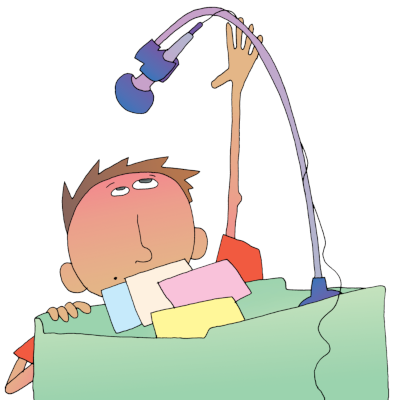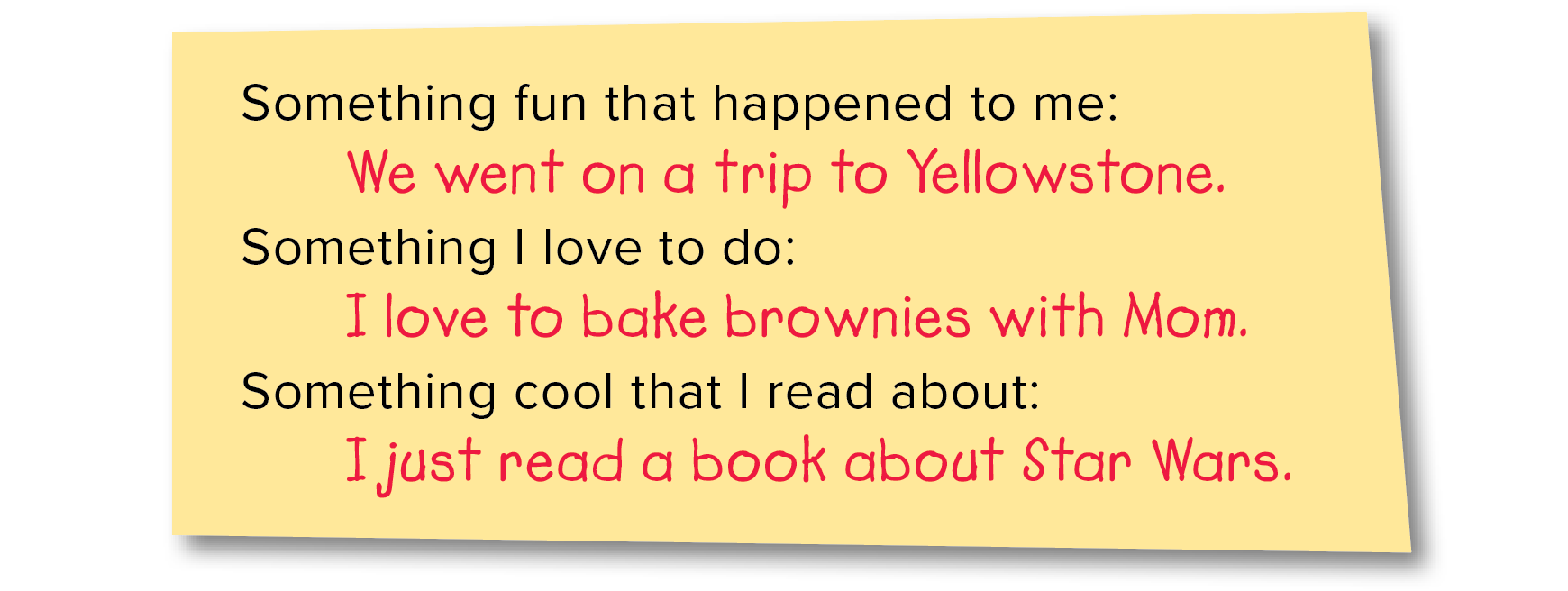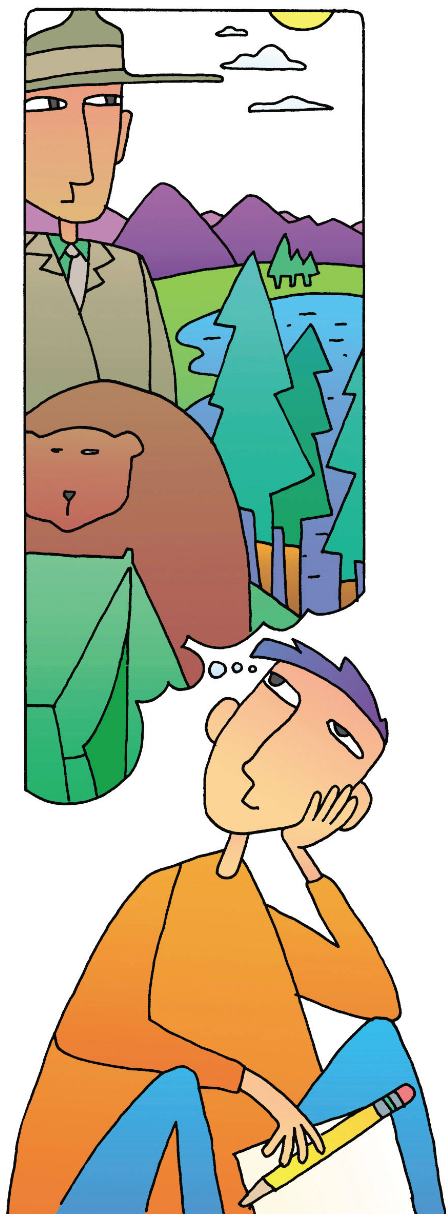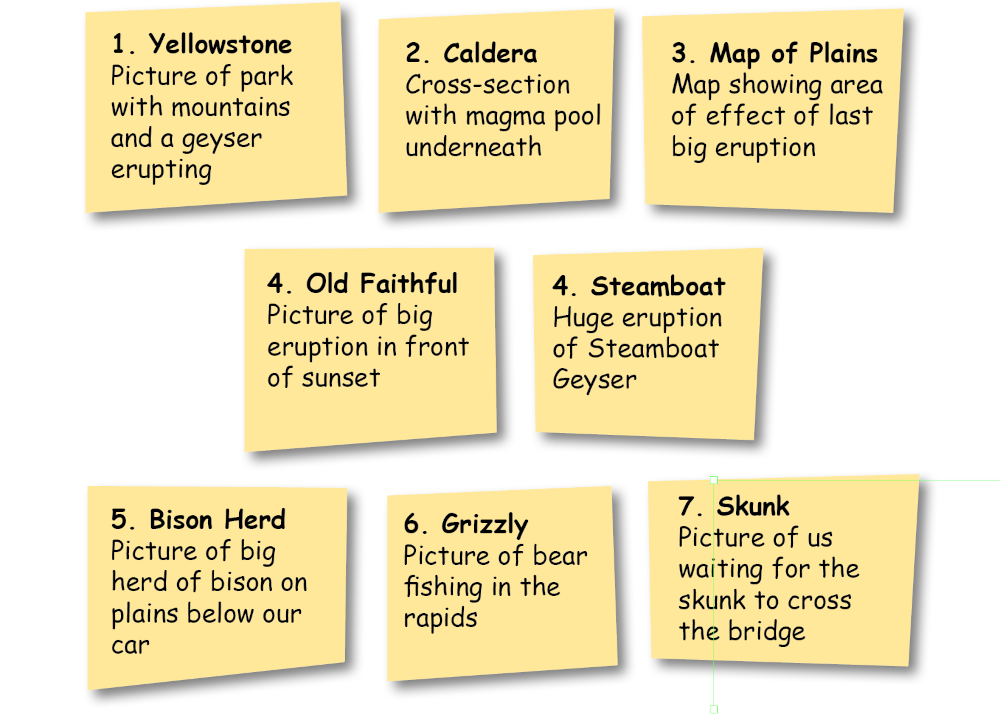WT 260
Page 260
Giving Speeches

When your teacher stands in front of the class and says something, that’s a speech. When a person gives a toast at a wedding, that’s a speech. When a comedian tells jokes to a crowd, that’s a speech. What kind of speech would you like to give? You can teach something, or inspire people, or even get them to laugh!
No Jitters, Just Fun!
Talking to a group is just like talking to friends. You might feel nervous, but guess what—those people are just people. They want you to succeed! If you choose a topic that you love and write out your speech before you start, you can just relax and have fun. This chapter will show you how.
WT 261
Page 261
1. Pick a topic you love.
List topics you’d like to talk about—things your class would like to hear about. Use these prompts:

Choose a topic and write a single sentence about it. Everything in your speech will share details about this topic.
2. Gather details about your topic.
List what you remember, read more to fill in details, and ask other people about the topic.
Remembering 🟪 Write down everything you remember about your topic. Fill a whole page! Later you’ll pick and choose what to share.
Reading 🟪 Read more about your topic. Ask your teacher or librarian for books. Search for Internet articles. Take notes, filling another whole page.
Asking Questions 🟪 Write down questions about your topic. Then ask someone who knows and write down answers. This is called interviewing. (See pages 280–283 for help.)
WT 262
Page 262
3. Know your purpose.
Why do you want to talk about your topic? The answer is your purpose. Do you want to . . .
🟪 share a wonderful experience,
🟪 teach your listeners about something cool,
🟪 make them laugh or feel sad, or
🟪 get them to agree with you about something?
4. Plan your speech.
Think about what your listeners would like to hear about your topic. Planning your speech will make you confident. Here are some tips:
To BEGIN your speech . . .
🟪 say something interesting or surprising to get your listeners’ attention and
🟪 tell what your topic is.
In the MIDDLE of your speech . . .
🟪 give interesting facts about the topic and 🟪 tell how you feel about it.
To END your speech . . .
🟪 remind listeners what your topic is and
🟪 repeat an important idea about it.
WT 263
Page 263
5. Write your speech.
To help you prepare for your speech, write it down. You can write it out just like any other essay. (See page 265.) Or you can write the main ideas on note cards. (See the sample note cards below.)

WT 264

Page 264
6. Practice giving your speech.
If you’re using note cards, practice saying the ideas listed on each card. Do this over and over until you can repeat all of the ideas easily. If you have written your speech out word for word, practice reading it or try to memorize it. Here are more practicing tips:
🟪 Practice early, at least two days before your speech.
🟪 Give your speech in front of friends or family members. Ask them what they think.
🟪 Follow the tips listed in step 7 below.
Tip
Think about what visual aids you might use. (See pages 266–267.)
7. Give your speech.
🟪 Speak loudly, clearly, and slowly.
🟪 Look at your audience. If you’re reading your speech, look up often.
🟪 Try to stand still. Avoid foot tapping or slouching during speeches.
WT 265
Page 265
Sample Speech
Here’s a short speech written by Jason Whitson.
Yellowstone
Name the topic in a way that hooks listeners. Have you ever stood inside a volcano? How about a supervolcano? I have—when my family took a trip to Yellowstone!
Yellowstone is a supervolcano that is more than 40 miles wide. It sits atop a huge magma chamber that had a gigantic eruption 640,000 years ago. It shot 240 cubic miles of ash and lava into the air and destroyed the Great Plains. Another eruption like that would reach us even here!
Give interesting facts. Yellowstone is still active now. It is full of amazing geysers like Old Faithful. It shoots 5,000 gallons of water into the air every hour or so. Steamboat Geyser shoots even more. There are also many colorful hot springs and stinky mud pots to see.
Yellowstone also has a lot of wildlife. We saw huge herds of bison and elk. We also saw a grizzly bear! There are wolf packs in the park, too, and many beavers and deer. On one trail, we saw a skunk wander across a bridge in front of us! The animals are beautiful but wild, so stay back!
Repeat the most important idea. If you want an amazing adventure, go to Yellowstone and stand in a supervolcano!
WT 266
Page 266
Adding Visuals
You can use a slide-show app like PowerPoint™ to add pictures, maps, diagrams, and other visuals to your speech.
1. Plan your slide show.
Use sticky notes or just a sheet of paper to make a storyboard of your slide show. Create a box for each main idea in your talk. Here’s a storyboard for the speech “Yellowstone.”

WT 267
Page 267
2. Gather your pictures.
Collect files of photos, maps, and diagrams, or draw your own pictures and scan them. Place all the images in a digital folder.
3. Build your slide show.
Create a file for your presentation and put images on separate slides. Arrange your images in the best order. You can also create text boxes to label images or provide credits for pictures you have collected.
4. Practice your presentation.
Run through your speech, clicking through your slide show as you do so. When you are ready, give your speech to classmates, friends, or family. Listen to their comments and make changes.
5. Give your presentation.
Stand in front of your audience and project pictures on a screen. Speak loudly, clearly, and slowly. Look at your listeners and don’t fidget. Enjoy sharing your speech!
